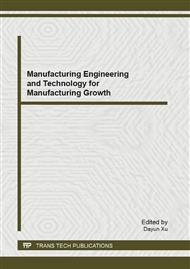p.119
p.123
p.128
p.135
p.144
p.150
p.156
p.161
p.166
A Study of Cutting Parameters Optimization in High-Speed Milling GH4169 with TiAlN Coated Carbide Tool
Abstract:
The orthogonal experiment is processed for high-speed milling superalloy GH4169 with TiAlN coated carbide inserts. The surface roughness prediction model based on cutting parameters is established by using the least-squares regression method. And the effect of cutting parameters on surface roughness is studied. According to the prediction model of surface roughness, a model of cutting parameters optimization by using genetic algorithm based on annealing penalty function is established for maximum material removal rate under specified surface roughness values. Obtain the optimal parameter combination when the surface roughness Ra≤0.2µm, and the experimental validation is done. These results provide the basis for improving processing efficiency of processing GH4169 and choosing parameters under specified constraint conditions.
Info:
Periodical:
Pages:
144-149
Citation:
Online since:
December 2012
Authors:
Price:
Сopyright:
© 2013 Trans Tech Publications Ltd. All Rights Reserved
Share:
Citation:


